Spring in bloom
Spectacular magnolias, flowering cherries and ornamental crab apples light up the spring garden. By planting a range of varieties with different flowering times, we can enjoy a wave of colour from August through to October.
Magnolias
Few trees command more attention than a deciduous magnolia in early spring. There is a magnolia to suit almost any garden. Star magnolias (Magnolia stellata) are large deciduous shrubs, about two metres wide and tall with intriguing white or pink asterisk-like flowers in late winter. The saucer magnolia, Magnolia soulangeana are lovely low branching trees crammed with upright tulip flowers, a great anchor tree in the corner of a garden.
Magnolia’s favourite soil combines excellent water holding ability with perfect drainage - cool, moist, lime-free and humus-rich. The best magnolias grow where well-drained soils meet a healthy rainfall, as happens in many parts of New Zealand. Many have been bred in this country, most famously by the Jury family in Taranaki. Jury hybrids, such as ‘Milky Way’, ‘Felix Jury’, ‘Apollo’, and ‘Vulcan’, are renowned for their ability to flower at a very young age, compared to older magnolias, which can take up to seven years to bloom.
For small gardens
‘Cleopatra’ and ‘Genie’ were bred by Taranaki plantsman Vance Hooper. Both produce large flowers at an early age, and are compact trees ideal for small gardens. ‘Cleopatra’ has rich purple flowers in early to mid spring. 'Genie' conjures up a profusion of pink-red flowers both before and after the leaves emerge and they’ll persist well into January. The foliage is pleasingly small and a rich dark green.
If you love the fragrance and colour of magnolias but need something evergreen, look no further than closely related Michelias. Their flowers are smaller and less showy than magnolias but extremely prolific, and michelias are handsome all year round with excellent foliage. The compact and very free flowering michelias known as ‘Fairy Magnolias’ make excellent small garden trees. They can also be trimmed as topiary or hedging.
Magnolia success
- Plant in cool, moist, lime-free and humus-rich soil. Enrich the soil before planting with ample compost.
- In heavy soil, drainage can be further improved by planting in a slightly raised bed.
- More sun means more flowers, but in a hot climate the cool soil on the shady side of the house may give better results. In hot, dry or windy locations pay extra attention to watering, mulching and shelter.
- Keep the soil moist, especially in the first year. After planting, add a layer of organic mulch. Magnolia roots grow close to the surface. In a natural forest situation the roots grow out into the leaf mould on the forest floor to absorb nutrients.
- In coldest climates an untimely spring frost can wipe out an entire flowering season. The best way around this is to plant later flowering magnolias.
- Prune only if you need to control shape or size. In smaller gardens, its best to plant smaller growing varieties but trees can be kept smaller than nature intended by trimming each year, immediately after flowering.
Did you know?
Before there were bees and butterflies, there were magnolias. For company they had dinosaurs and also beetles, which were among the first insects to visit flowers. Typical of flowers visited by beetles, magnolias are large and open with protruding carpels (female flower parts) designed to attract attention.
Flowering cherries
Their flowering may be brief but it is one of springs most breathtaking highlights. Flowering cherries (Prunus) in full spring bloom are so packed with flowers that they resemble frothy clouds. Falling blossom covers the ground like a sprinkling of snow. Flowering cherries are also know for their beautiful shape, and soft green foliage which turns vibrant colours in autumn.
Profuse flowering Prunus ‘Accolade’ is a wide spreading tree, a favourite for larger spaces. Popular ‘Shidare Sakura’ is a smaller weeping tree with frilly double flowers in mid-spring. ‘Amanogawa’ grows bolt upright, ideal for narrow spaces. Prunus pendula ‘Rosea’, the rosebud cherry, is a long-time favourite small weeping tree. Prunus x yedoensis, the lovely spreading Yoshino cherry, bursts out in early spring with a profusion of blush white single blossom. Its NZ raised offspring, Prunus x yedoensis ‘Awanui’, has large shell pink blooms on a similar spreading form, making a lovely shade tree. There are many more to choose from. If you have room for more than one, plant varieties with different flowering times so you can enjoy the show for longer. On the other hand a whole avenue of one variety is heavenly in full bloom.
Flowering crab apples
Flowering crab apples (Malus) are generally later flowering than the cherries. Their mass of blossom usually coincides with the emergence of fresh lime-green leaves, which add to the effect. Crab apple trees offer an interesting range of shapes from shrub-like dwarf trees to narrow-upright, wide-spreading, and weeping forms. While some can exceed seven metres tall at maturity, this takes many years so they make excellent small garden trees.
The Japanese flowering crab (Malus floribunda) is a picture in full bloom, with wide arching branches clothed in a delightful multi-tone display of tight red buds and pink flowers that fade to white. This tree is very true to its name; floribunda means an abundance of flowers. They’re fragrant too. In autumn there are tiny yellow apples, which birds love. Malus floribunda makes a stunning lawn tree, best given plenty of space for its wide umbrella canopy to spread. For smaller gardens, the prairie crab, Malus ‘Ioensis Plena’ is a clear favourite. Its compact frame produces a spectacuar display of large, fragrant double pink flowers in late spring.
Crab apples, such as Malus ‘Gorgeous’, ‘Tom Matthews’ and ‘Jack Humm’ are grown mainly for their vibrant winter display of baby apples (great for jelly making), but spring blossom is an added bonus. These are small shapely trees, just three or four metres tall at maturity.
How to grow beautiful blossom trees
- Plant in a sunny position with well drained soil, enriched with compost and controlled release fertiliser. Flowering crabapples and cherries will tolerate clay soils as long as they are well drained but moist, with no standing water.
- Allow enough space to allow the tree to spread to its natural form.
- Water during dry spells and apply mulch to keep moisture in, especially in the first year after planting.
- In dry or windy locations pay extra attention to watering, mulching and shelter.
- Some cultivars may produce suckers at the base of plants. Remove these as they don’t flower and will ruin the shape of the tree.
- Apply slow release fertiliser at planting time but avoid high-nitrogen fertiliser.
- Some circulation is healthy, but protect trees from harsh wind that can strip the blossom and destroy a tree’s shape.
Spring in a pot
Spring blossom comes in many forms. If your garden is a balcony or tiny patio try a mini peach or almond tree in a pot, or a columnar apple tree. The amazing ‘Ballerina’ apples grow just 30cm wide but they’re covered in spring blossom and then loads of autumn fruit. Flowering quince (Chaenomeles), traditionally a large spring flowering shrub, is delightful grown as a topiary ‘lollipop’ tree.
Mainly for fruit but flowers too
Prunus and Malus varieties bred mainly for their fruit may not be quite as showy as their ornamental cousins in spring, but they’re still very pretty in bloom. Take your pick from a delicious range of apples, pears, peaches, plums, nectarines, apricots, almonds and quinces. If you’re short on space, grow them sideways along a fence, espalier style.
3-Sep-2012

Magnolia Genie
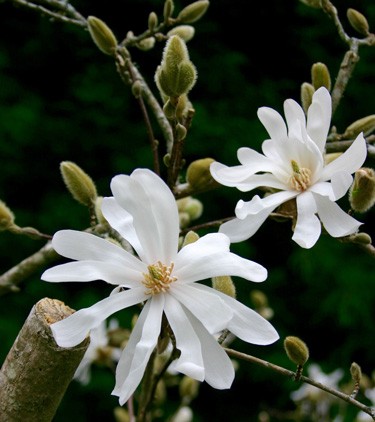
Magnolia stellata alba
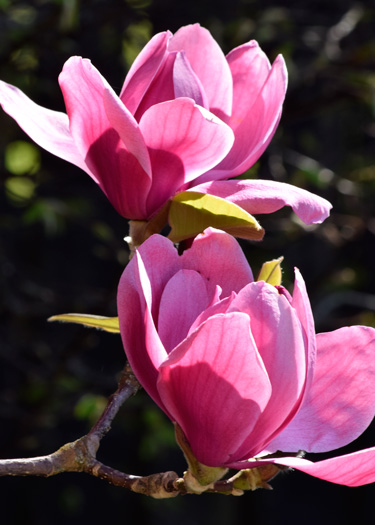
Magnolia 'Vulcan'
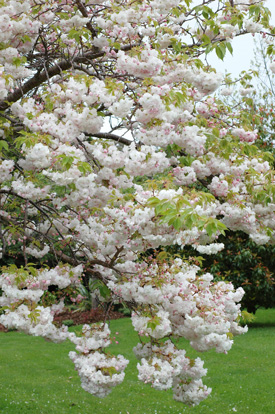
Flowering cherry
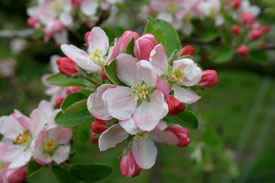
Apple blossom
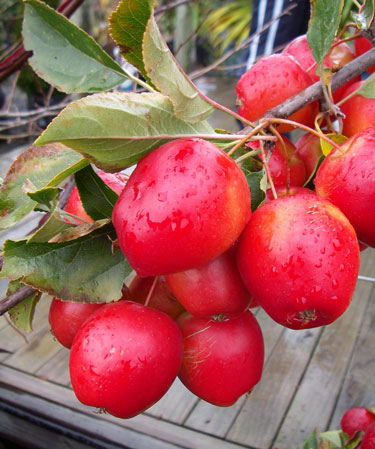
Crab apple 'Jack Humm'


